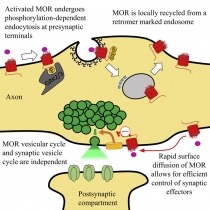A simplified schematic of a chemical synapse between neurons, with the axon terminal region at the presynaptic side expanded (top) relative to the postsynaptic side (bottom). The net effect is to maintain a mobile surface pool of opioid receptors (MORs) that can laterally diffuse into the terminal, enabling terminals to remain opioid-responsive under conditions that desensitize other opioid effects.
Newly published research from a team of international scientists offers new insight on how opioid receptors work to regulate chemical communication in the brain, a process called neurotransmission. During neurotransmission, movement of specialized molecules (neurotransmitters) are released from nerve terminals across synapses, or spaces between the brain’s neurons.
When people take opioid pain medications or illicit opioids like heroin, the drugs cause effects such as pain relief, sedation, itching, nausea, euphoria, and decreased respiration. They produce these responses by activating specialized receptors that affect the way brain cells communicate with each other in the neurotransmission process. Understanding how to manage and manipulate these receptors could help prevent or treat addiction to opioids.
The new research, done by NIDA-funded scientists, upends previous assumptions about how presynaptic opioid receptors function on nerve terminals. It had been assumed that these were immobilized on the surface of the terminal. However, this study demonstrated that the receptors are diffusely distributed, can exist outside of the synapse in the neuron’s axon, are very mobile, and can even move between synapses. This lateral mobility reveals a dynamic and inherent flexibility of the receptors’ function.
The findings also change our concept of how the opioid receptor signals to alter neurotransmission. It was previously assumed that binding to the receptor and signaling occurred in a single step. Here the authors show that opioids can bind to presynaptic receptors outside of the synapse and then diffuse to terminals where they can attach to signaling proteins—so that receptor binding and signaling can occur in separate steps.
The scientists suggest that these newly discovered mechanisms could result in an alternate strategy for achieving local control of presynaptic effects that would preclude receptor immobilization. Overall, this study offers new insight on the basic biology and function of presynaptic receptors.
The research was done by scientists from University of California at San Francisco; University of Geneva in Switzerland; Interdisciplinary Institute for Neuroscience in Bordeaux, France; the Salk Institute for Biological Studies in California; and the Oregon Health and Science University in Portland.
Study:
- Damien Jullié, Miriam Stoeber, Jean-Baptiste Sibarita, Hanna L. Zieger, Thomas M. Bartol, Seksiri Arttamangkul, Terrence J. Sejnowski, Eric Hosy, Mark von Zastrow. A Discrete Presynaptic Vesicle Cycle for Neuromodulator Receptors. Neuron.
